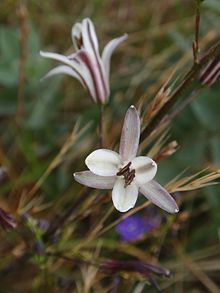- Chlorogalum pomeridianum
-
Chlorogalum pomeridianum 
Scientific classification 
Kingdom: Plantae clade: Angiosperms clade: Monocots Order: Asparagales Family: Asparagaceae Subfamily: Agavoideae Genus: Chlorogalum Species: C. pomeridianum Binomial name Chlorogalum pomeridianum
(DC.) KunthChlorogalum pomeridianum, the Wavy-leafed Soap Plant or California soaproot, is the most common and most widely distributed of the Soap Plants, Soaproots or Amoles, which make up the genus Chlorogalum of flowering plants. It is found in most of California, apart from the Sierra Nevada and the deserts, and also in south-western Oregon. It is occasionally known as the "wild potato", but given the plant's lack of either resemblance or relationship to the potato, this name is not recommended. Wavy-leafed Soap Plant grows on rock bluffs, grasslands, chaparral, and in open woodlands.
Contents
Description
Like all the Soap Plants, the Wavy-leafed Soap Plant is a perennial that grows from a bulb, which is brown, between 7 and 15 cm in diameter, slightly elongated, and covered in thick, coarse fibers. The leaves grow from the base of the plant, and can be from 20 to 70 cm long and 6 to 25 mm wide.[1] As the plant's name indicates, their edges are generally wavy, though this is not always particularly noticeable. The flowers are borne on a long stem, normally longer than the leaves, and are from 15 to 30mm long. The six petals (actually only three of them are petals in the technical sense; the other three are sepals) are up to 35mm long and curving. They are typically white but have a noticeable mid-vein which can be purple or green in color. The six stamens are large and noticeable, and yellow or orange. The flowers are bisexual (include both female and male parts). They open only in the late afternoon or evening, remaining open during the night but closing by the morning. Pollination is by evening- or night-flying insects.
Subspecies
Three varieties are recognized:
- Chlorogalum pomeridianum var. divaricatum, endemic to some coastal regions of California (the Central Coast and southern parts of the North Coast), and only found at elevations below about 100 metres.
- C. p. var. minus, found in the inner north and outer south Pacific Coast Ranges of California, and the San Francisco Bay Area. This variety has a less fibrous bulb than the others.
- C. p. var. pomeridianum, found throughout the range of the species.
Uses
The juices of the bulb contain saponins that form a lather when mixed with water,[2] and both Native American people (e.g. Miwok tribe[3]) and early European settlers used the bulbs as a kind of soap; this is the origin of the plant's name. It was particularly used for washing hair, since it was held to be effective against dandruff. Extracts of the bulbs could also be used as a sealant or glue.
The young leaves can be used as food, but the saponins in the bulbs make these poisonous. However saponins are very poorly absorbed by the body and usually pass straight through, and in any case they can be destroyed by thorough cooking. The Miwok people roasted and ate the bulbs as a winter food. In February 1847 Patrick Breen of the ill-fated Donner Party recorded that a Native American gave the starving settler some "roots resembling Onions in shape [that] taste some like a sweet potatoe [sic], all full of little tough fibres." Breen's son later called the roots "California soap-root" -- almost certainly C. pomeridianum.
Saponins are much more toxic to some other animals than they are to humans. Fish are particularly susceptible, and the bulb juices were used to kill or stun them so they could be caught easily. The bulbs also had various medicinal uses, both external (e.g. for making a poultice to be used as an antiseptic, or as a rub in cases of rheumatism) and internal (decoctions were used for a range of purposes, including as a diuretic, as a laxative and against stomach ache). The fibers surrounding the bulb were widely used, bound together, to make small brushes.
The basionym of the species was Scilla pomeridianum. It has also been known as Loathoe pomeridiana.
Notes
References
- Jepson Manual (1993) Chlorogalum pomeridianum
- C. Michael Hogan (2008) Ring Mountain, The Megalithic Portal, ed. A. Burnham
- Palomar Soap Lilies in California (1998)
- NRCS: USDA Plants Profile: Chlorogalum pomeridianum
External links
Categories:- Agavoideae
- Flora of the West Coast of the United States
- Flora of Oregon
- Flora of California chaparral and woodlands
- Flora of the Sierra Nevada region (U.S.)
- Natural history of the Santa Monica Mountains
- Native American cuisine
- Traditional Native American medical plants
Wikimedia Foundation. 2010.
